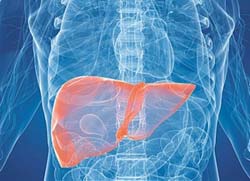Blood Test Instead of Biopsy Identifies Liver Damage

The ELF test (Enhanced Liver Fibrosis test) takes approximately one hour to complete and requires only a blood sample. The process is therefore less invasive but just as reliable as the previously required biopsy, and it usually takes about a week to deliver a biopsy result.
The new test was developed by Siemens Healthcare in collaboration with University College London and can be used as a routine test on the Siemens ADVIA Centaur Immunoassay System.
Liver fibrosis is the result of chronic liver damage caused by vi-ral hepatitis, alcoholic cirrhosis, or fatty liver disease. It is characterized by scarring of the liver tissue, which can lead to cirrhosis or cancer of the liver over the long term — a frequent cause of death worldwide.
At present, the “gold standard” for assessing the severity of a liver fibrosis is a liver biopsy, which involves the removal of a small amount of liver tissue. This biopsy has drawbacks, however: It is painful; it entails some risk for the patient; and it tests only a small sample of the liver.
With the automated ADVIA Centaur ELF Test, a fast and mini-mally invasive technique is now available for determining both the severity of a liver fibrosis and the risk that it will worsen. The test examines three direct blood serum biomarkers: hyaluronic acid (HA), procollagen III N-terminal propeptide (PIIINP), and the tissue inhibitor of metalloproteinase 1 (TIMP-1). These direct biomarkers are molecules that are involved in the formation of fibrosis. In the test, special reagents react with the biomarkers and generate light in the process. The greater the intensity of this chemiluminescence, the greater the presence of the biomarker.
A special algorithm is used to convert the results of the three biomarkers into the ELF score, which indicates the degree of fibrosis. The combination of three biomarkers increases the accuracy of the test. As an international clinical trial has shown, the ELF test can precisely differentiate between slight, moderate, and serious cases of fibrosis. In the event of slight or moderate fibrosis, patients normally have no symptoms. Doctors can thus intervene before significant damage to the liver and monitor the progress of therapy.
To complement the ELF test, Siemens is also offering imaging and laboratory diagnostic technologies like hepatitis blood tests and ultrasound systems that help physicians identify liver fibrosis at an early stage and monitor its development.
Media Contact
More Information:
http://www.siemens.com/innovationnewsAll latest news from the category: Life Sciences and Chemistry
Articles and reports from the Life Sciences and chemistry area deal with applied and basic research into modern biology, chemistry and human medicine.
Valuable information can be found on a range of life sciences fields including bacteriology, biochemistry, bionics, bioinformatics, biophysics, biotechnology, genetics, geobotany, human biology, marine biology, microbiology, molecular biology, cellular biology, zoology, bioinorganic chemistry, microchemistry and environmental chemistry.
Newest articles

High-energy-density aqueous battery based on halogen multi-electron transfer
Traditional non-aqueous lithium-ion batteries have a high energy density, but their safety is compromised due to the flammable organic electrolytes they utilize. Aqueous batteries use water as the solvent for…

First-ever combined heart pump and pig kidney transplant
…gives new hope to patient with terminal illness. Surgeons at NYU Langone Health performed the first-ever combined mechanical heart pump and gene-edited pig kidney transplant surgery in a 54-year-old woman…

Biophysics: Testing how well biomarkers work
LMU researchers have developed a method to determine how reliably target proteins can be labeled using super-resolution fluorescence microscopy. Modern microscopy techniques make it possible to examine the inner workings…





















